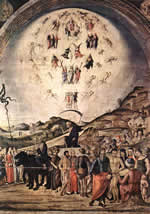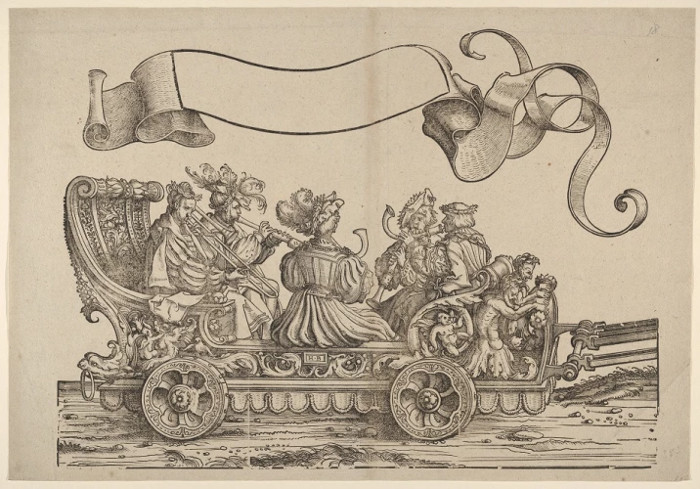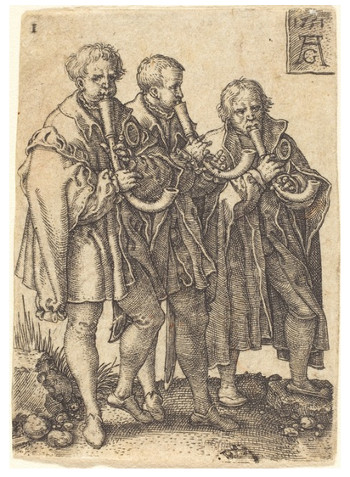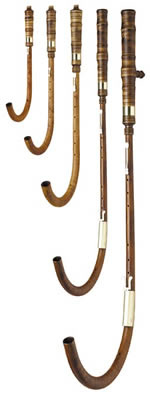"Spaert gheen Cromhorens, Herpen, Luyten, Velen"
Johann David HeemsenJohann David Heemsen (1581–1644), in Nederduytsche Poëmata, 84 (Antwerp 1619). (source: Woordenboek der Nederlandsch taal, VIII, pt. 1, col. 325, The Hague 1882–1971)
The History of the Crumhorn
The crumhorn, with its curious umbrella handle shape, was probably originated during the fifteenth century in Germany which remained the principal area of its use. The term "Krummhorn" (meaning bent horn or crump from the older English, meaning curve) was used in Germany from about 1300 on, apparently to describe a curved lip-reed instrument. Its characteristic curvature and wind cap may have evolved from the curved animal horn of bladder pipes and bagpipes. The great Greek comedy dramatist Aristophanes mentioned in his Lysistrata a wind instrument called physalis (from Old Greek: physa = bladder, bellow). An early representation of bladder pipes, both straight and curved, appears the famous Cantigas de Santa Maria (fig. 1) from the time of Alfonso X "El Sabio" (1221–1284).

Lorenzo Costa
1488
Fresco. S. Giacomo
Maggiore, Bologna
The little child at the lower right corner of the painting probably holds a crumhorn. This refers to an early awareness of the instrument in Italy.
The characteristic curve is purely decorative and is probably a reminder of earlier wind instruments. It have been curved to shorten its length and make the pipe less clumsy for the player.
Crumhorns produce a range in tone from a gentle, somewhat nasal humming to a rich, resonant buzzing. The have a characteristically sharp attack which is very effective in an ensemble. Due to their limited range, music for crumhorns is usually played by a group of instruments of different sizes and hence at different pitches. Such a group is known as a consort of crumhorns. The crumhorn was turned out of a length of wood, which was then bored out, filled with sand, plugged, and the lower end steamed (to soften it) and finally bent into a half circle. The curved bell section of many surviving instrument is hollowed out to form a more or less conical foot, which has the effect of raising the volume.
The true crumhorn is already mentioned as "Krummpfeyffen" at the court of Albrecht Achilles of Ansbach (1440–1486). Its earliest appearance as an organ register dates from 1489, used in Dresden for a reed register of the Dreikönigskirche. At the wedding of Duke Johann of Saxony to Sofia of Mecklenburg at Torgau in 1500, the Mass was accompanied by instruments including four crumhorns.
The earliest appearance of a crumhorn in painting dates from about the same time, in Lorenzo Costa's Triumph of Death even though it occupies a very marginal part in the composition. However, in Carpaccio's Presentation of Christ in the Temple) (fig. 2) it plays a far more significant visual role.

Francesco Vittore Carpaccio
1510
Tempera on panel, 421 x 236 cm.
Gallerie dell'Accademia, Venice
Another crumhorn can be found in the precious intarsie of the Stanza della Segnatura in the Vatican, which is decorated with Raphael's most famous frescoes. The room once housed the library of pope Julius II together with a collection of musical instruments. The wooden intarsie, which survived the horrifying Sacco di Roma in 1527, provide invaluable documentation of Renaissance musical instruments.Emmanuel Winternitz, Musical Instruments and Their Symbolism in Western Art (New York: Yale University Press, 1967). Among the instruments are five crumhorns.
Descriptions of crumhorns in Italian treatises are ambiguous. The earliest of two major treatises is Johannes Tinctoris' De inventione et usu musicae, (Naples c. 1484) which describes a "doulcina," referring to the softness of its sound along with a few other characteristics of a crumhornThe representation shows seven fingerholes and a thumbhole, therefore the limit of pieces to be played on. but it does not mention the instrument's appearance. The second is Ludovico Zacconi's Prattica di musica (Part 1, Venice 1596). In his discussion of musical instruments, Zacconi provides scattered information on instruments that seem to be related to the dolzaine, functionally identical to the crumhorn and its probable medieval antecedent. They are cornamuti torti, sordoni, cornamuse and doppioni. The two described instruments with the adjective torto (bent), the corno torto and the cornamuto torto, were probably the cornett and the crumhorn.
In Germany the crumhorn appears in various engravings. Emperor Maximilian I (fig. 3), although known to be particularly keen on tournaments, was nonetheless one of the greatest patrons of the sciences, literature and arts of his time. He maintained a large and exquisite court band, the "Hofkapelle." Some of the most renowned musicians, like the Franco-Flemish composer Heinrich Isaac and his most famous pupil Ludwig Senfl were employed at his court. To ensure that posterity would remember him as he wished, Maximilian commissioned a number of biographical richly decorated books with engravings as well as a monumental triumphal procession, Triumphzug, represented in a series of 137 woodcuts, designed and supervised by Albrecht Dürer. Roughly half of the woodcuts were executed by the German painter and printmaker Hans Burgkmair (see Shawm).

Hans Burgkmair
c. 1512–1519
Woodcut, published 1526
The ensemble consists of two crumhorns (descant/alto), two shawms (alto/tenor) and a trombone.
Among the various instruments in the Triumphzug we find in one of the carriages five musicians playing "Schalmeyen, Pusaunen vnd Krumphörner" (shawms, trombones and crumhorns).
The two principal semi-biographical works of MaximilianMaximilian either wrote the Theuerdank himself or dictated it to his secretary, Marx Trautsauerwein. were the Theuerdank (1517), which raccounts in allegorical form his travels and courtship for his first wife, Mary of Burgundy, and the Weisskunig1514, unfinished, first edition Vienna 1775. which deals with the life of Maximilian's parents, his own birth and education and his campaigns and battles. The volume is elaborately decorated with 251 woodcuts, half of which executed by Hans Burgkmair. Print no. 33 shows the musical education of the young Weisskunig.Weiss is a German word-play meaning "white" for the young king's silver armour, as well as the German "weise" = "wise"; referring to Maximilian as a "wise king." For details to the depicted instruments see Christine K. Mather, "Maximilian I and his Instruments," Early Music 3, no. 1 (January 1975): 42–46. The accompanying text to the woodcut is headed (in old German spelling): "Wie der jung weyß kunig die musica und saytenspil lernet erkennen" ("How the young white king learned music and to play string instruments").

Heinrich Aldegrever
1551. e
Engraving. Vienna, Graphische Sammlung Albertina
Aldegrever's monogram "AG" shows a close resemblance to that of Albrecht Dürer, whom Aldegrever deeply admired.
Although the title of this print refers to string instruments, the print demonstrates how wind instruments predominated over strings in the sixteenth century. This is also evident in the inventory of musical instruments of the English King Henry VIII which listed 77 recorders, 25 crumhorns and 5 cornetts but only 25 viols.
An engraving by the German painter and engraver Heinrich Aldegrever shows three crumhorn-players (fig. 4). By this time the crumhorn, like with nearly all of the other woodwind instruments, had established a true family (exilent/descant, alto, tenor, bass or great bass), and three-voice music-pieces suitable for crumhorns were rather rare in the limited repertory for this instrument.
The three principal German treatises (Virdung, Agricola, Praetorius) all contain descriptions and depictions of the crumhorn and its relatives. The first is Sebastian Virdung's Musica getutscht (Basel 1511). He described the crumhorn as a soft-toned double-reed consort instrument and labeled a woodcut with a set of four of them, together with other related instruments.
Martin Agricola's woodcut in his Musica instrumentalis deutschWittenberg 1528, revised ed. 1545. may have been copied from Virdung's work. Beside a set of four crumhorns it also shows a "Platerspil" (as a possible predecessor of the crumhorn) and an animal horn of similar name ("Krumphorn," probably a Gemshorn).
Both Virdung and Agricola described a basic consort of four instruments in three sizes: one descant in g, two tenors in c, and a bass in F, although the woodcuts appeared to depict four different sizes of crumhorns. But it was customary to employ two crumhorns of the same size to play the tenor and alto parts, commonly called tenor, alto-tenor or tenor-alto size. The explanatory texts of these treatises offer little except for some diagrams with fingerings and tablatures, which, however, has at least shed some light on playing technique.
The most important contribution to the crumhorn (fig. 5) is to be found in Michael Praetorius' Syntagma musicum (3 vols, 1615–1620). Praetorius added only one size to the basic consort —the great bass—but there is also evidencee.g. a purchase of a set of crumhorns by the city of Nuremberg. of a small exilent size, tuned a fourth (c') above the descant's g. Praetorius was the first to discuss the difficulties of tuning and intonation of a crumhorn consort. While the members of other woodwind consorts (recorder and shawms in particular) were normally separated by fifths, the sizes added to the basic three-species crumhorn consort were tuned a fourth from their neighbors, probably a concession to the crumhorn's limited range. Praetorius suggested a combination of fourths and fifths in the tuning of a crumhorn ensemble in order to improve the intonation. So the instruemtns of the basic group were separated by fifths, while the added sizes (exilents and great bass) were tuned a fourth from their neighbors.
Sizes of crumhorns and their range, listed by Michael Praetorius
| 1. small descant or exilent | c' – d'' |
| 2. descant | g – a' |
| 3. alto-tenor | c – d' |
| 4. bass | F – g |
| 5. great bass | B' – c or C – d (with extra keys for B' and A) |
Even though they were not described by Praetorius, tenor crumhorns sometimes had keys and sliders to extend their range downward which could be found on several surviving tenor crumhorns. These instruments show the greatest variation of all crumhorn types: normal ranges with or without key as well as extended instruments with one or two keys.

ltr: soprano, alto, tenor, bass and great bass.
Praetorius considered an "ideal" set of crumhorns as one having nine instruments. He recommended one exilent, two descants, three tenor-altos, two basses, and one great bass. This set was not universally available: most of the sets were far more modest, containing usually four instruments (a descant, two tenors, one bass), which corresponded rather to the consorts described by Virdung and Agricola.
The only known crumhorn maker was the German Jörg Wier (first half sixteenth century) from Memmingen (South Germany). His workshop was renowned even in Nuremberg, the center for wind instrument making, and developed into an important distribution center for Memmingen crumhorns. The Duke of Bavaria, the Elector of Saxony and the cardinal of Trent purchased crumhorns via Nuremberg but "made in Memmingen." Today a number of museums and collections for musical instruments (Vienna, Berlin, Leipzig, Merano, Brussels) are proud owners of original or workshop Jörg-Wier-crumhorns. Wier probably employed at least one maker, and they might have divided the work according to instrument size.See also Barra Boydell, "Ioerg Wier."